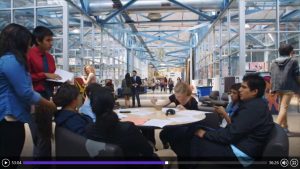Greg Whiteley’s 2015 video documentary, “Most Likely to Succeed” opens with a quote by John Dewey: “If we teach today as we taught yesterday, we rob our children of tomorrow” (00:19). This quote perfectly summarizes the message of this documentary: the film shows the viewer that the education system that was designed to prepare the workers of the industrial age for the workplace is no longer suitable in the twenty-first century, in the age of information technology.
Although the narrator tells us that they visited many schools while shooting the documentary, “Most Likely to Succeed” focuses on High Tech High, a charter school in San Diego, California, presenting this school’s theory of change. The problem this charter school – and the movie – identifies is that in today’s world, where more and more jobs are taken over by robots and computers, people are going to need different skills than they did for the most part of the twentieth century. However, the United States’ education system did not really change since its implementation at the beginning of the industrial age: the subjects are divided, students spend a lot of time preparing for and taking tests, they cover a lot of content material that they only have to know until exam day. High Tech High takes a completely different approach to education with the goal of better preparing its students for the contemporary world. In this charter school, classes are not divided into subjects, but rather, teachers cooperate to create different projects that combine several subjects. Students are encouraged to think independently, to work in groups, to be creative, and teachers also have complete freedom in what and how they teach – in exchange for not having tenure and having to renew their contracts every year. Students’ and teachers’ work is not assessed by tests or exams, but by projects presented at an exhibition night held each term. This way, the school is hoping to teach its students “soft skills”, skills that will help them to become citizens capable of innovative thinking.

The screenshot above is from a scene that I believe conveys one of the key arguments of the documentary. In this scene, the narrator is talking about the fact that when choosing to send their children to High Tech High, parents are making a bet: they are choosing between “traditional” schools, private or public, that might better prepare their students to ace tests and thus go to college, and a charter school that – with no proof that it is really going to improve these children’s chances in life – takes a totally different approach to education. The way this scene is shot really shows that the filmmakers would bet for High Tech High: first, when the narrator says, “one side of the bet: continue down the traditional path” (52:44), the film is showing a school’s traditional hallway lined with lockers, moving past them, literally “continuing down”. The “traditional path” is also illustrated by black-and-white footage of a boy, sitting in front of a pile of books. Then, we switch to scenes of High Tech High, and the contrast is obvious: students are sitting and learning together in a big group, not struggling alone with textbooks, the hallway is not lined by metal lockers, but it is wide open, made out of glass, filled with colorful art. The see-through glass walls symbolize that in this school, nothing is separated: students need to work together, people can look into classrooms, the subjects are combined, so there is no need for separate spaces dedicated to only one class or only one subject. This is why I think the screenshot I chose really shows what the idea is behind this new type of school, how it completely reimagines education and learning.
In my opinion, the way students learn in High Tech High would definitely prepare them better for the challenges of today’s and the future’s job market and workplace than traditional public schools. Also, as at the end of the documentary the narrator tells us, even though they do not prepare specifically for exams, students from the school still perform above state average (1:20:10), and 98 percent of their graduates gets into college (1:20:19), showing that the school does well in traditional measures as well. However, the documentary does not tell us how the ideas and methods could be expanded further, how this type of education could be adapted to teach a wider circle of children, not just the lucky ones who get into High Tech High in a lottery, which would be important if the aim is to better prepare the future generation for the jobs and lives they are going to encounter.
Source:
Whiteley, Greg (2015): Most Likely to Succeed. Video documentary.